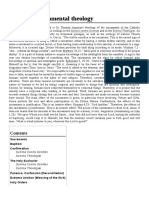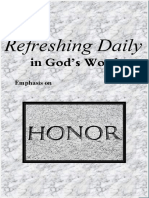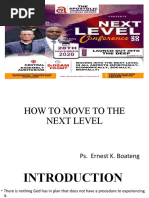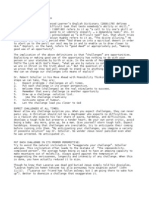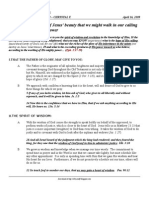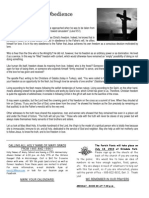Bible Study Guide
Uploaded by
MC MelclavBible Study Guide
Uploaded by
MC MelclavHow to Prepare a Bible Study
This is a simple method for pastors or lay leaders to prepare a Bible study. The primary tool is the Bible.
Secondary resources can be useful but are not necessary. Some free useful websites will be listed at the end.
There is a difference between a sermon and a Bible study:
Sermon Bible Study
• One direction: speaker to audience • Participatory: interaction between teacher &
students
• Delivery: Exhortation • Delivery: Question and interaction
• Preacher is the expert • People self-discover the truth
• Answers are given • Answers are discovered
1. Pray: The first step in studying the Bible is to pray and ask the Holy Spirit to speak to you as you study the
Bible.
2. Choose a passage: This may be a chapter or section. Most modern Bibles are divided into sections and
paragraphs. If you choose too much, you will not be able to focus the study well.
3. Read the passage: Read the passage five to ten times. Read the chapter in which the passage is found. If
you have not read the entire book of the Bible, do so as well.
4. Identify the key theme(s): Most passages will have 1-3 key themes. Look for themes related to salvation,
our relationship to God, or our relationship to other people (the two greatest commandments). There may
be other themes also since the Bible is complex and speaks to every need we have. Identify the key theme
for each paragraph or set of verses. Summarize the passage by giving your study a title that becomes the
focus of your study.
5. Develop an outline of the passage based on the key themes.
6. Ask Questions: Base these questions on the contents of the passage. The questions may be: who, what,
when, where, how, or why. Choose the questions that help reveal the key themes and are answered by the
passage.
7. Connect to the needs of your group. Ask questions that highlight and explain the theme and also help
apply this theme to your group. Why and how is this passage important to your group? Prepare stories and
locate other Bible passages that help illustrate the themes of your passage. Use a concordance to find other
verses.
8. Prepare: If you want to create a handout (optional), provide the outline and key questions you have
already identified. Limit questions to no more than 5-10, depending on your time limit.
9. Pray: Ask God to work through the study to speak to your group. Pray for each person in your group by
name and for visitors.
Two helpful websites for Bible study are
• http://www.biblegateway.com
• http://www.blueletterbible.org
Example Study
1. Pray: “O Lord, speak to my heart as I look into Your word. Help me to find ways to apply it to my life and
the life of my group.”
2. Choose a passage: Colossians 1:3-9
3. Read the passage:
4. Identify the key theme(s):
Major Theme: The Benefits of the Good News
What happened to the Colossians when they came to believe
5. Develop an outline of the passage based on the key themes.
1. The Reason for Thanks (v. 3)
2. The Qualities of the Colossians (vv. 4-5)
3. What the Gospel does (vv. 6-8)
6. Ask Questions (you can give verse references if you want to help the group):
• Why did Paul give thanks for the Colossians (v. 3)?
• What spiritual qualities did the Colossians have (vv. 3-5)?
• What does the Good News bring to us (v. 6)?
• What did the Colossians do when they heard the Good News (v. 6)?
• What are the character qualities of Epaphras (v. 7)?
• What did the Holy Spirit do for them once they heard and believed the Good News (v. 8)?
• Additional Bible verses can be cross-referenced that touch upon the themes above.
7. Connect to the needs of your group.
• What impact has hearing the Good News made in your life? Can you share a story?
• What should be our response to hearing the Good News?
• Why should we respond this way? What are the benefits to us?
• What is required of us to respond this way?
• What keeps people from responding to the Good News?
• What resources does God give us to help us when we respond?
8. Prepare: A simple handout could be prepared with these questions or the leader can use his or her own
notes. Everyone should have a Bible to use and study.
9. Pray: Pray for each person who will attend the study.
This Bible study should be included with other elements during the meeting. Here is a suggested outline:
1. Fellowship
2. Praises through song
3. Sharing of praises and concerns, testimonies, accountability
4. Prayer for one another
5. Bible study
6. Closing prayer with time of response and commitment
Total time: 60-90 minutes
You might also like
- Summary and Analysis Essay On Biblical Preaching50% (2)Summary and Analysis Essay On Biblical Preaching13 pages
- 70 Days Prayer and Fasting Programme 2017 Edition D. K. Olukoya 2024 Scribd Download100% (6)70 Days Prayer and Fasting Programme 2017 Edition D. K. Olukoya 2024 Scribd Download42 pages
- Leadership of Christian Women in The ChurchNo ratings yetLeadership of Christian Women in The Church4 pages
- PDF - 31 Days Faith Declaration - Day 1 - Day 10No ratings yetPDF - 31 Days Faith Declaration - Day 1 - Day 1072 pages
- 235 Powerful Morning and Evening Prayers That Will Change Your Life Forever: Violent Prayers For Healing, Favor and Financial ProsperityNo ratings yet235 Powerful Morning and Evening Prayers That Will Change Your Life Forever: Violent Prayers For Healing, Favor and Financial Prosperity15 pages
- Guidelines For The Understanding of The Scriptures: Dr. J. Vernon McgeeNo ratings yetGuidelines For The Understanding of The Scriptures: Dr. J. Vernon Mcgee40 pages
- Jesus Freaks: A Bible Study For Those Who Refuse To Deny JesusNo ratings yetJesus Freaks: A Bible Study For Those Who Refuse To Deny Jesus59 pages
- The Intercessor E28093 A Prayer Warrior Who Has The Gift of Intercessory Prayer100% (1)The Intercessor E28093 A Prayer Warrior Who Has The Gift of Intercessory Prayer6 pages
- Christian Discipleship Foundation Studies Session One Set Ablaze Event MinistriesNo ratings yetChristian Discipleship Foundation Studies Session One Set Ablaze Event Ministries6 pages
- Word of Faith School of Ministry Instruction Manual and Monitoring JournalNo ratings yetWord of Faith School of Ministry Instruction Manual and Monitoring Journal40 pages
- Bible Workers Training Manual_241208_042930No ratings yetBible Workers Training Manual_241208_04293048 pages
- Dispensationalism by David Dunlap EnlargeNo ratings yetDispensationalism by David Dunlap Enlarge20 pages
- Childrens Shorter Catechism Questions For Small ChildrenNo ratings yetChildrens Shorter Catechism Questions For Small Children11 pages
- Roman Catholic Mass Songs Chords Amp Lyrics Vol 2No ratings yetRoman Catholic Mass Songs Chords Amp Lyrics Vol 2177 pages
- Lesson 3 - God His Character and AttributesNo ratings yetLesson 3 - God His Character and Attributes7 pages
- Canaan Baptist Church May Newsletter JUNE 2013 - Growing in ChristNo ratings yetCanaan Baptist Church May Newsletter JUNE 2013 - Growing in Christ8 pages
- Planning A Non-Eucharistic Liturgy TemplateNo ratings yetPlanning A Non-Eucharistic Liturgy Template4 pages
- Centennial & Alumni Homecoming Mass Line-UpNo ratings yetCentennial & Alumni Homecoming Mass Line-Up3 pages
- The Freedom of Obedience: By: Pope Benedict XVINo ratings yetThe Freedom of Obedience: By: Pope Benedict XVI2 pages
- Theological Significance of Jesus Christs Death On The CrossNo ratings yetTheological Significance of Jesus Christs Death On The Cross22 pages
- How We Benefit From Jehovah’s Love | Watchtower StudyNo ratings yetHow We Benefit From Jehovah’s Love | Watchtower Study1 page



